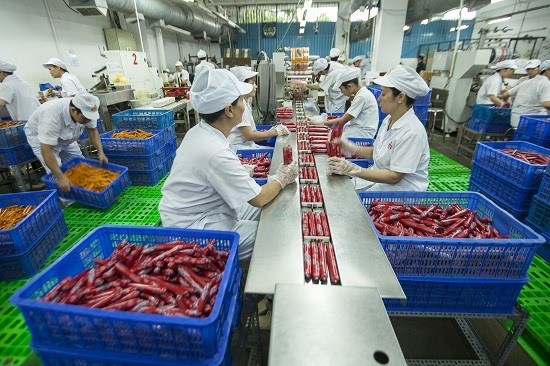
The food processing and drinks industry has seen growth of 7 percent in recent years, with more and more foreign investors deciding to pour money into the sector.
In HCM City, food and drinks represented 17 percent of total retail revenue last year. (Photo: baotintuc.vn).
"The food and
drinks sector is now taking the largest proportion of monthly spending for the
Vietnamese, around 35 percent,” Pham Thanh Kien, Director of the Ho Chi Minh
City Industry and Trade Department, was quoted as saying in theSai Gon
Giai Phong(Liberated Sai Gon) newspaper.
In HCM City, food and drinks represented 17 percent of total
retail revenue last year.
Export turnover for food processing and agricultural products
totalled more than 40 billion USD last year.
Vietnamese products have successfully reached many technical
standards and quality barriers and are present in 200 countries, including the
US, Japan, the Republic of Korea and the EU.
For foreign investors, the abundance of agricultural products
and foodstuff in the country is an advantage. Vietnam is considered one of the
top five food baskets in the world and one of the top 15 largest countries by
agriculture exports.
The young population and the rising popularity of processed
food are two other factors influencing investors’ decisions.
For the last five years, many international food-processing
companies have and expanded their production in Vietnam.
In the coming time, the Government plans to withdraw
its shares in major food processing and drink companies like Vinamilk or Habeco
and create more opportunities for foreign investors.
Foreign investors have also invested in and expanded their
trade centres, supermarkets and convenience stores, which have all helped to
increase consumption of processed foods.
Multinational retailers like Circle K, 7-Eleven, B’s mart,
Family Mart, MiniStop, Big C, Aeon and Lotte now have a total of 3,000
convenience stores, 300 trade centres and supermarkets in Vietnam.
"This also means more competitive pressure for the domestic
food processing and drink manufacturers,” said Ly Kim Chi, Chairwoman of the
HCM City Food and Foodstuff Association.
Currently, 98 percent of domestic manufacturers are small and
medium size with limited financial resources and poor competitiveness.
"Foreign distributors and manufacturers have a strategy to
dominate the Vietnamese market. Distributors have reduced expenditures to the
producers, while the latter have dropped selling prices or increased
promotions,” she said.
"Foreign distributors have also established barriers like
quality and packaging standards and many others so they can refuse domestic
products,” she added.
"To compete on the home ground, domestic enterprises must
increase their production capability, quality and packaging to meet
international standards,” said Huynh Thanh Dien from HCM City’s University of
Economics.
"For long-term development, domestic enterprises should join
international supply chains. Authorities should also apply the same incentive
policies for foreign and domestic companies,” he added.
Many foreign companies receive preferential treatment on land
rent, taxes and technology imports.
"Authorities should also prevent unhealthy competition when
foreign enterprises work together to try to eliminate local ones and engage in
dumping practices,” he said.
Vietnam has 5,500 food and drink manufacturing enterprises,
with 2,000 of them located in HCM City.-
Source: VNA
After more than four years of implementing a project launched by the Hoa Binh Party Committee’s Standing Board on developing agriculture and promoting product consumption linked with building new-style rural areas for the 2021-2025 period, the province’s industry and trade sector has made significant strides, greatly contributing to local socio-economic development.
Luong Son district has identified 2025 as the year for the accelerated breakthrough to successfully implement the socio-economic development plan for the 5-year period from 2021 to 2025. The district has been focusing on executing the plans and trying to achieve a GRDP growth rate of approximately 15%.
Since the beginning of this year, under the direction of the Department of Agriculture and Environment, the Sub-Department of Agricultural, Forestry, and Fishery Product Quality Management has strengthened the integration of the professional activities to promote and guide the organizations and individuals in the production and trading of agricultural, forestry, and fishery products to comply with the legal regulations regarding the use of chemicals, pesticides and veterinary medicines in crop cultivation, livestock farming and aquaculture. They also provide guidance to processing and manufacturing establishments on keeping the records to trace the product origins and using food additives from the approved list according to the regulations.
Hoa Binh province saw a significant rise in state budget revenue in the first two months of 2025, heard a meeting chaired by Vice Chairman of the provincial People’s Committee Quach Tat Liem.
Ha Thi Ha Chi, a 26-year-old graduate in law, has taken an unconventional path by returning to her hometown in Mai Chau district to establish the Tong Dau Cooperative, creating stable jobs for local women and bringing Thai ethnic brocade weaving to the global market.
As the Lunar New Year 2025 approached, pork prices surged, creating a profitable season for farmers in Tan Vinh commune, Luong Son district. Taking advantage of the rising demand, Can Minh Son, a farmer from Coi hamlet, sold over 30 pigs at 69,000 VND/kg, each weighing more than 100 kg. After deducting expenses, his family earned a profit of over 50 million VND.


